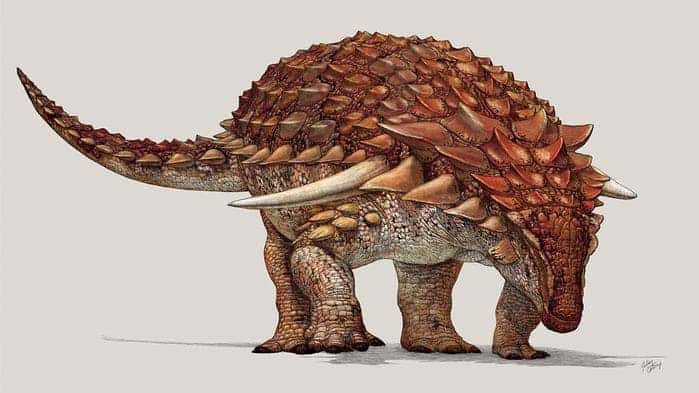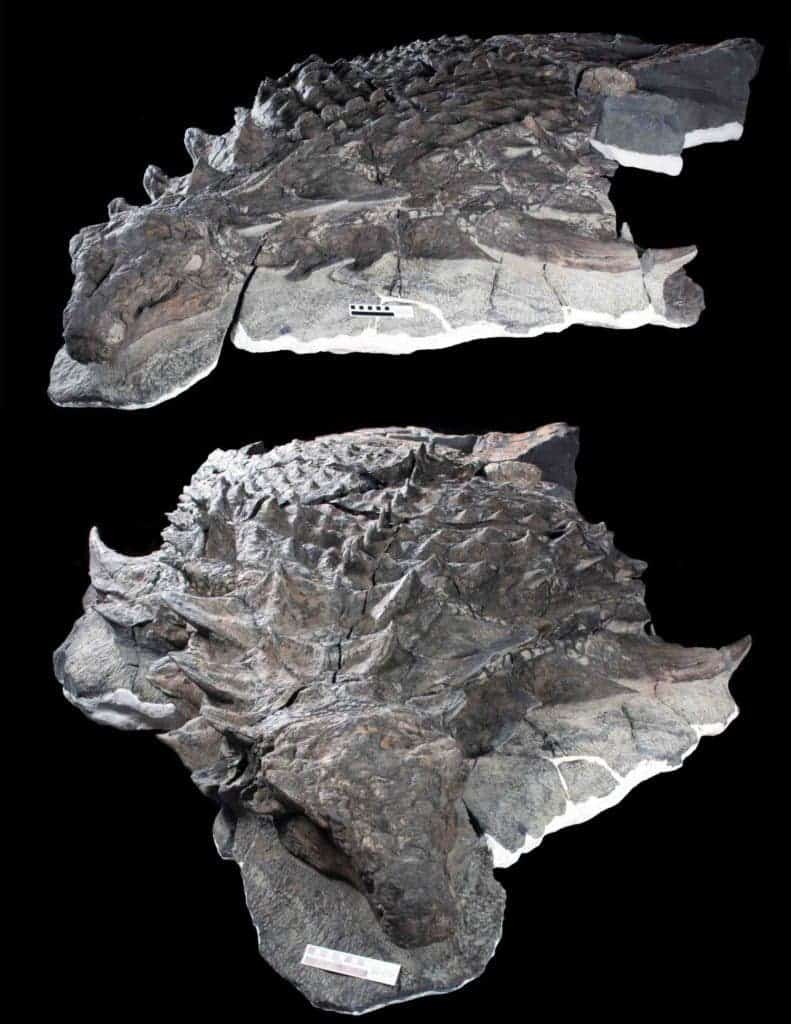Dinosaurs’ thick, bony armor plates seem custom-tailored to absorb damage and deter predators. But a new paper describing the keratin layer adorning these plates in Borealopelta markmitchelli reports their armor might have had an even more important role: helping the dinos get some action.

The bone plates of armored dinosaurs were covered in a more flexible tissue made predominantly of keratin. This formed all sorts of shapes and structures, such as caps and horns. Up to now, it’s been impossible for paleontologists to say how big or varied these structures are, simply because they almost never find them preserved in fossils.
We actually very rarely get a good impression of what dinosaurs outwardly looked like from fossils. The size, shape, and overall structure of the dinos you see in museum exhibits can be reliably observed from them. But stuff like their color, the texture of their skin or scales, the color of their eyes, those are, for the most part, our imagination at work. Fossilization requires quite a fair bit of luck and time, and the process involves high pressures, temperatures, as well as some pretty aggressive chemical substitutions. So by their very nature, fossils are bad at preserving the soft bits that give organisms their distinctive flair.
Researchers at the Royal Tyrrell Museum of Palaeontology in Drumheller, Canada, however, were lucky enough to get their hands on a Borealopelta markmitchelli fossil that beautifully preserves some of these characteristics. Discovered by a Suncor Energy mining machine operator Shawn Funk at an oil sand mine north of Fort McMurray, Alberta, it preserves not only the bony armor but also much of the layer of softer, keratin-rich tissue covering it.
The team reports that the structures are very reminiscent of the growth patterns of antelope horns and other defense-and-display structures in animals today, suggesting that dinosaurs did not shy away from using their looks to get attention.
“They might have been billboards, basically, to advertise for the animal,” says Caleb Brown, a vertebrate palaentologist at the museum.
One of kind

Image credits Royal Tyrrell Museum of Palaeontology, Drumheller, Canada.
This is actually the first B. markmitchelli ever found. The animal likely lived some 110 million years ago and belonged to the nodosaur family of dinos. Measuring in at some 5,5 meters (18 feet) in length, weighing over 1,300 kg (2,800 pounds), and clad in thick bone plates, this was a tank of a beast. Fortunately for us, it found its end in an environment that swallowed it up before fully decomposing. The fossil’s exquisite condition allowed Brown and his team to measure both the bone plates and keratin caps from the animal’s snout to the hips.
They report that the flat-ish bone plates closer to the animal’s tail were covered in a thin layer of keratin-rich material, likely there to protect it from wear and tear and provide some structural rigidity. This crust of keratin, however, got much thicker towards B. markmitchelli‘s shoulders and head. It formed large ornaments which capped the bone spikes on the dinosaurs’ neck plates, and represented up to one-third in length of the tusk-like spines on its shoulders. Wherever you look on the body, the taller the bone plate’s spikes jutted out, the thicker its keratin cap on top, according to the team.
Brown says this structure is very similar to what we see in horns and antlers today, both of which are used to fend off attackers but also serve to show off to potential mates and rivals. The fact that B. markmitchelli‘s most elaborate decorations are near the front of the animal (much like modern antlers and horns) also suggests that they were used for social signaling. Two male rivals facing off, for example, would have ample opportunity to see (and be intimidated by) each other’s thickest, most lavish stretch of armor.
All in all, these characteristics suggest that B. markmitchelli‘s spikes might have evolved (at least in part) as a means of social communication, a way for them to impress mates, scare off rivals, or both. However, Brown agrees that this remains largely speculative while working from a single specimen. We’ll have to find other fossils in a similarly good condition to know for sure.
Until then, the findings will further our understanding about the patterning on dinosaurs’ armor, and how it evolved over time. Previously, Brown showed evidence of countershading camouflage in use by the species, showing just how dangerous carnivorous dinosaurs must’ve been to force such a heavily armored beast into hiding.
The paper “An Exceptionally Preserved Three-Dimensional Armored Dinosaur Reveals Insights into Coloration and Cretaceous Predator-Prey Dynamics” has been published in the journal Current Biology.






